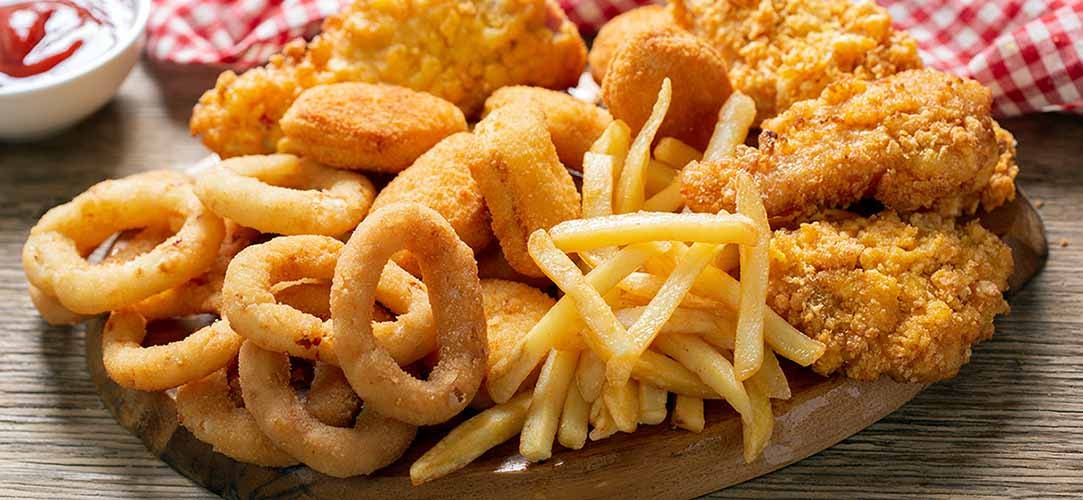The Fascinating History of Fried Foods
By: Matthew Berry • March 21, 2023 • 20 minute read time
The Fascinating History of Fried Foods
Concession stands are often synonymous with hand-held fried food. But where did those foods come from? It can be challenging to determine the origin of foods, but we'll do our best to sift through the sands of time and come up with at least a good story.
On our path, we'll encounter conquerors, refugees, and traders. We'll meet entrepreneurs looking to improve old recipes to make more popular food. They'll all share their crispy creations with the people they encounter, no matter where their journeys take them.
Where did French fries come from?
The famous thinly sliced potatoes fried in boiling fat until crispy are ubiquitous worldwide. While the name implies a French origin, and the Spanish conquest of the Incan Empire in the 1500s made them the first Europeans to come into contact with potatoes, it was most likely the Belgians who created french fries.
Local legend says the delicacy was created in the 1680s in Namur, Belgium. That winter, the story goes, the rivers froze, preventing the locals from catching and frying fish, a favorite regional food.
They turned to the potato, and a few centuries later, when American doughboys fighting in World War I encountered the thinly cut batons of deep-fried potatoes, they assumed they were French because that was the language spoken in the region.
While the American soldiers may have misnamed french fries, the name or phrases it derives from predate The Great War.
A more likely origin of the name is a reference to its preparation.
Frenching is a cutting method that creates evenly sized pieces, basically julienning. This is why you'll often see french fries spelled with lowercase f's. Whether the name comes from geographically-challenged G.I.'s or a fancy way to cut potatoes, it's easy to see how once the rivers thawed in Namur during that frigid winter, they may also have invented fish and chips.
Who made the first onion rings?
Slicing onions, coating them in a batter, and deep frying them is obviously delicious; it's no wonder it's been developed worldwide.
One of the earliest examples of batter-coated fried vegetables is pakora, originating in India in the 16th century.
A recipe that essentially gives you the modern onion ring was first published in 1802 by John Mollard in the British cookbook "The Art of Cookery Made Easy and Refined."
The first published reference in the U.S. comes more than a century later in a 1908 edition of the Fort Wayne (Ind.) Sentinel, with a "French Fried Onions" recipe by Fannie M. Farmer. Two years later, the New York Sun reported french fried onion rings had become "a novelty that progressive New York restaurants are introducing with great appreciation from their patrons." A Crisco ad in a 1933 edition of The New York Times Magazine is credited as one of the first widely published recipes for onion rings.


Where was fried chicken first made?
Pieces of chicken coated in a seasoned batter and deep-fried until juicy, golden, and crispy.
This one's easy, right?
We all know fried chicken originated in the southern United States.
Well, kind of.
In the 1747 British cookbook "The Art of Cookery, Made Plain and Easy," the author Hanna Glasse included a recipe "To marinate chicken," a method similar to traditional Scottish ways of frying chicken. However, Glasse's mixture of wine, nutmeg, and parsley probably isn't the Colonel's secret recipe.
As more and more Scottish people migrated to the southern United States, they brought their fried chicken techniques with them. In her seminal 1824 cookbook "The Virginia House-Wife," Mary Randolph published a recipe that would clearly be fried chicken to modern diners.


A likely reason for the development of the recipe is who was cooking it. By the mid-19th century, enslaved African Americans had fully embraced the cooking method as part of their culture and probably brought West African traditions of seasoning to it.
While it was also key to the food culture of white people in the antebellum South, it "became a route to economic empowerment for many African Americans." An example of this from pre-refrigeration days was African American women selling fried chicken to train passengers because it traveled easily. This led to roadside fried chicken restaurants, the most successful of which was Harland Sanders'. "Colonel Sanders," as he became known, founded what would become KFC. He's also credited with popularizing using a pressure fryer, which he used instead of a frying pan.
The quicker cooking method allowed Sanders' restaurant to franchise across the planet, cementing the connection of southern-style fried chicken as the quintessential fried chicken. It sometimes supplanted, influenced, or existed alongside fried chicken traditions in South Korea, Japan, Guatemala, the Palestinian territories, and elsewhere.
What's the history of corn dogs?
O.K., this one is American. We can definitely say that.
Where and when? That's where things get as cloudy as day-old deep fryer oil at a county fair.
Like many of humanity's most significant discoveries, the corn dog, as we know it today, was the brainchild of multiple groups and individuals working independently from one another.
Whether inspired by a breaded sausage or out of frustration, all of these innovators came to the same solution:
- Spear a hot dog on a wooden stick.
- Coat it in a batter containing at least some cornmeal.
- Deep fry it.
In the first several decades of the 20th century, sausages or hot dogs encased and baked in cornmeal were popular. In 1940, more than 70,000 were sold over three weeks in New Orleans alone, and there are mentions of them being all the rage in Dallas the year before.
A 1929 catalog includes a listing for the "Krusty Korn Sausage Dog Pan." The device baked a hot dog inside batter while shaping the batter into something resembling an ear of corn.
The earliest mentions of sausages fried in cornmeal date to the 1920s, first in Texas. German immigrant sausage makers dipped the links in batter and fried them to make them more appealing to customers who shied away from the non-fried sausages.
The second case was in Adel, Iowa, where Roger Newman ran out of hot dog buns while serving food at a high school sporting event. He went to his tavern, coated the hot dogs in cornmeal batter, fried them, and brought them back to the game.
Notice the lack of sticks in both examples.
A 1927 patent by Stanley Jenkins of Buffalo, N.Y., shows us sticks for the first time.
Jenkins' creation, the "Combined Dipping, Cooking, and Article-holding Apparatus," was a device "for dipping edible articles impaled on sticks" into a liquid for either coating or frying. Jenkins envisioned the device could be used for everything from "weiners, boiled ham, [and] hard-boiled eggs" to "sliced peaches, pineapples, [and] bananas."


There's no evidence to suggest that Jenkins ever sold what we'd call corn dogs. So let's credit him as the grandfather of fried food on a stick.
Two groups claim they created the modern corn dog on a stick in the 1940s.
George Boyington created Pronto Pups in a fit of frustration. The story goes that Boyington worked at a concession stand over Labor Day weekend in 1939 when a rain storm destroyed his hot dog buns. He decided he needed a way to cook buns at the stand. His eventual solution: coat the hot dog in batter and fry them. Thus, was born the Pronto Pup, a name he trademarked in 1942.
At about the same time, brothers Neil and Carl Fletcher had seen sausage baked in cornmeal in Dallas and decided to adapt the concept for a quicker fried version. They spent months working on it before launching their "Corny Dogs" at the 1942 Texas State Fair. You can still find Pronto Pups at the Minnesota State Fair, where they've been since 1947, and the Fletcher family still sells Corny Dogs every year at the Texas State Fair.


When was battered, deep-fried fish created?
Tracking the history of fried fish will be simpler if we limit the definition to fillets coated in a batter of flour and eggs and deep-fried until crispy.
So, for simplicity's sake, we will.
But this straightforward answer still has a long and far-reaching path.
The first recorded recipe for battered fried fish comes from a 12th-century Moorish cookbook. The recipe, called hut mu'affar, starts with lightly poached fillet rolled in a mixture of bread crumbs or wheat flour, eggs, pepper, coriander, cinnamon, and spikenard (an ingredient now mainly used in hair tonics like Vitalis), and then fried in olive oil.
The method spread from the Iberian Peninsula through trade routes to southern France, coastal Italy (where it's known as filletto di baccala), and Greece.
After the Reconquista asserted Spanish and Portuguese dominance over most of the peninsula, the dish, known as pescado frito in Spanish, spread in other ways.
The cooking method spread when Portuguese traders arrived in Japan in the 16th century. In Japanese, it became simply tempura.
Sephardic Jewish refugees fleeing the Inquisition brought the tradition to England and other welcoming areas of Europe and North Africa in the 17th century. By the 19th century, Sephardic fried fish had joined with fried potatoes to create the classic English fish and chips.
Japanese emigrates spread their version of deep-fried food to China, other parts of Asia, and the Pacific Ocean.
Japanese fishermen brought the technique to Mexico in the 1920s. They were hired to teach finishing and diving techniques in Ensenada, but they also seem to have taught their students how to tempura fry their catches, which led to the creation of fish tacos.
What's the history of mozzarella sticks?
Bread and cheese are a timeless combination that speaks to all humans' hungry stomachs. But wrapping a hunk of cheese in bread and throwing it into a vat of boiling oil is an act of madness so great it's genius.
Our earliest written recipe for batter-coated cheese fried in fat is from a 1393 French book called "Le Menagier de Paris." The recipe for pepefarces calls for mixing egg yolks, flour, salt, and wine and rolling thin slices of cheese in the batter. The cheese is fried in a skillet of beef marrow. However, Dr. Joel Jensen, an author and food historian, told the Thrillist in 2017 that modern cheese sticks didn't take their cues from medieval French appetizers. "In fact, modern mozz sticks probably have less in common with the long and storied history of Italians and French frying their cheese and more in common with pizza or French fries," Jensen told the Thrillist.
The modern mozzarella stick results from a confluence of culinary trends in the United States.
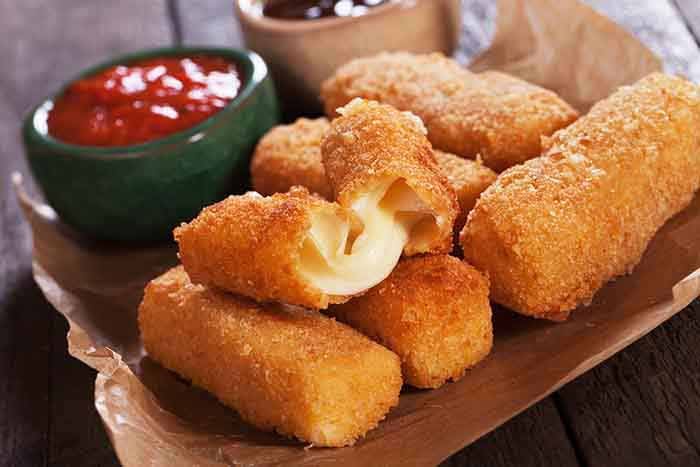

By the 1960s, mozzarella cheese was being mass-produced to meet growing demands for Italian-American food and pizza.
By the 1970s, advances in fryer technology made the cooking technique more widely available at places like bowling alleys and bars.
Unlike many other creations on this list, there are no legends about someone toiling away for years to perfect the mozzarella stick. But by the mid-80s, they were ubiquitous.
It's likely that, like the corn dog, they were created by multiple people over several years throughout the country (deep-fried cheese on a stick was even one of the many foods Stanely Jenkins listed on his 1927 patent for the Combined Dipping, Cooking, and Article-holding Apparatus).
Like the name of the medieval author who first wrote the recipe for deep-frying cheese, the creator of the modern mozzarella stick will remain anonymous. And perhaps that's for the best. After all, no one person should hold that kind of power.
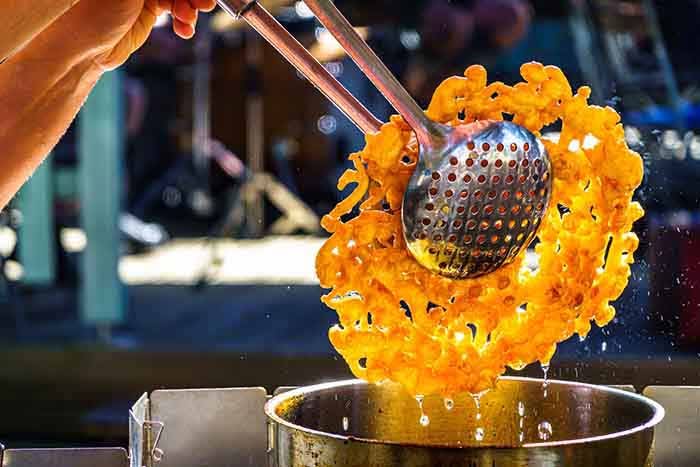

Where are funnel cakes from?
Frying batter is an ancient practice. Some sources claim fried cakes were made in Egypt and China as far back as 8000-5500 BCE.
Yeast-risen fried dough dishes are traced back to early-medieval Persian and Arab cuisine. The recipes spread to Europe; an early recipe is found in Anglo-Norman manuscripts. Many of these recipes use yeast and sourdough as leavening agents.
When Pennsylvania Dutch settlers came to Pennsylvania in the 17th and 18th centuries from what's now Germany, they brought recipes of batter poured through a funnel into hot oil with them. Eventually, baking soda became the leavening agent, and the modern funnel cake began to take shape, with a recipe appearing in 1935.
The treat became popular in the 1960s at the Kurtztown Folk Festival. Over the next few decades, funnel cakes spread nationwide as deep fryer technology improved.
What's the history of fried pickles?
As we covered above, battered and fried vegetables trace their history back to the 12th century on the Iberian Peninsula. The earliest recipe for the deep-fried pickles was published in a 1962 edition of the Oakland (Calif.) Tribune. That recipe used pancake mix and sweet pickles, creating a much different product than what you'll find at your local sports bar.
Arkansas restauranteur Bernell "Fatman" Austin is credited with popularizing fried dill pickles at his restaurant, the Duchess Drive-In in Atkins, Ark., about an hour west of Little Rock.
In 2014, Fatman's son David Austin told the Arkansas Democrat-Gazette that in the early 1960s, his dad started thinking about a way to use pickles to drum up business (the Duchess was located across the street from the Atkins Pickle Company).
He eventually hit on deep frying them and spent the next two years refining his recipe. By the summer of 1963, he'd perfected the recipe: cutting surfboard-shaped planks from whole dills pickles and breading them in a secret coating only known to fewer than 20 people.
The Hollywood Cafe in Robinsonville, Miss., also claims to be the birthplace of the salty, crunchy snack, but the Hollywood Cafe didn't open until 1969, a year after the Duchess Drive-In closed and Fatman had opened his second restaurant, the Longer.
In the next few decades, deep-fried pickles spread nationwide to sports bars, dive bars, and barbecue restaurants. They've grown so popular that national chains feature them on their menus.
When were arancini first made?
Arancini are fried rice balls stuffed with meat, tomato, or cheese. They are a Sicilian staple, available all over the island at bars and roadside stalls. They are a classic street food: easy to carry, quick to prepare, and delicious.
Arancini's were developed during the island's period of Islamic rule.
North African and Arab colonizers brought spices, fruits, and vegetables to Sicily in the 9th-11th centuries. A 10th-century recipe differs from the savory arancini common today. It included ricotta cheese, saffron, and other spices.
The name means "little oranges" in Italian, a fruit introduced to the island during Islamic rule. When Europeans retook the island, their cuisines were integrated into Sicilian food culture, including the reintroduction of pork, which became a filling in arancini. After the island's Spanish rulers introduced tomatoes in the 16th century, all the pieces were in place for arancini to become the popular snack it is today.
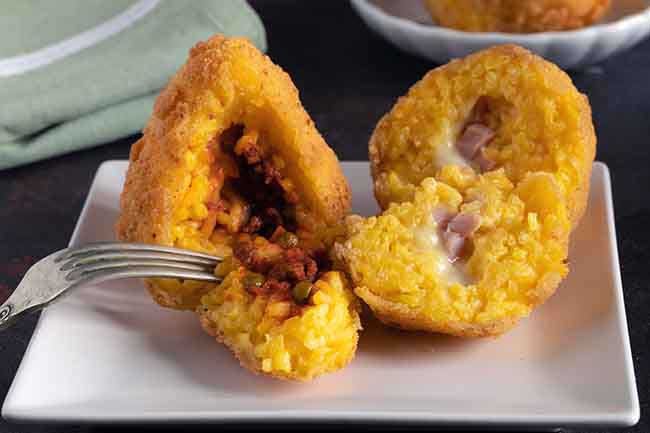

Where are empanadas from?
From the South Asian samosa, the Italian calzone, the Cornish pasty, and the Chinese xian bing, there's a laundry list of hand-held filled pastries around the world.
Every culture seems to have developed its own or influenced others. Empanadas, deep-fried pastries filled with meat, cheese, and vegetables, first appeared on the Iberian Peninsula during Moorish rule in modern-day Portugal and Galicia in northwest Spain. Its creation was possibly influenced by sfeehas brought to the region by the new Muslim rulers.
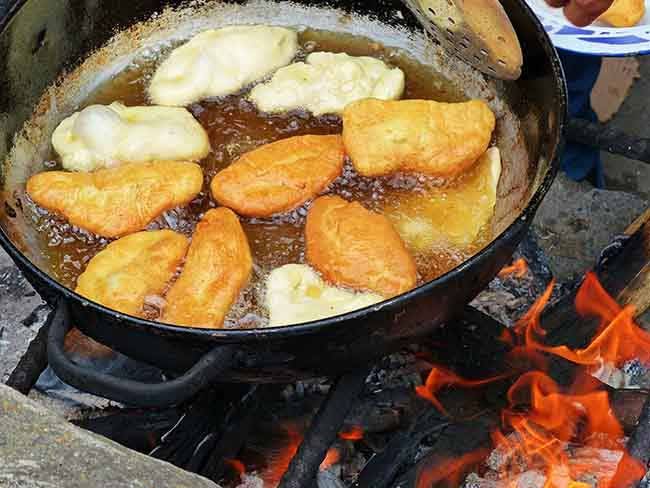

A recipe using the word "empanada," which comes from the Spanish word meaning to bread or to coat with bread, appeared in a 1520 Catalan cookbook by Robert de Nola. In the book, "Llibre del Coch," de Nola's empanadas are a double-crust pie cut into slices instead of the modern hand-held pastry. Empanadas shrank to their current hand-held size after Spain invaded the Americas in the 16th century, making them easier for workers and soldiers to eat while on the move and away from home.
Today's empanadas differ from region to region. The crust of Argentinian empanadas tends to be more pastry-like. In Venezuela and Colombia, corn flour replaces wheat flour. In parts of Central America and the Caribbean, yuca and plantain are used instead. Filipino empanadas use rice or galapong wrappers. In some places, empanadas are even baked.
But no matter how different they are and how integral they've become to their new homes, they all share a common link to medieval meat pie in Galicia.
The history of food is more than just people making recipes with ingredients they have on hand to sate their hunger. It's about exploration, trade, sharing culture, and adapting to new climates. And while it can also have a darker side of conquest and subjugation, time and time again, we've seen people groups survive and create and share new and existing food traditions wherever they go.
Share

